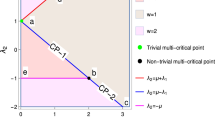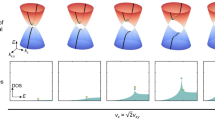Abstract
Topological phase transitions in condensed matter systems accompany emerging singularities of the electronic wavefunction, often manifested by gap-closing points in momentum space. In conventional topological insulators in three dimensions, the low-energy theory near the gap-closing point can be described by relativistic Dirac fermions coupled to the long-range Coulomb interaction; hence, the quantum critical point of topological phase transitions provides a promising platform to test the intriguing predictions of quantum electrodynamics. Here we discover a class of quantum critical phenomena in topological materials for which either the inversion symmetry or time-reversal symmetry can be broken. At the quantum critical point, the emerging low-energy fermions, dubbed the anisotropic Weyl fermions, show both relativistic and Newtonian dynamics simultaneously. The interplay between the anisotropic dispersion and the Coulomb interaction brings about a screening phenomenon distinct from the conventional Thomas–Fermi screening in metals and logarithmic screening in Dirac fermions.
This is a preview of subscription content, access via your institution
Access options
Subscribe to this journal
Receive 12 print issues and online access
$209.00 per year
only $17.42 per issue
Buy this article
- Purchase on Springer Link
- Instant access to full article PDF
Prices may be subject to local taxes which are calculated during checkout



Similar content being viewed by others
References
Sachdev, S. Quantum Phase Transitions 2nd edn (Cambridge Univ. Press, 1999).
Balents, L. Spin liquids in frustrated magnets. Nature 464, 199–208 (2010).
Xu, C. Unconventional quantum critical points. Int. J. Mod. Phys. B 26, 1230007 (2012).
Wen, X. G. Topological order: From long-range entangled quantum matter to a unified origin of light and electrons. ISRN Condens. Matter Phys. 2013, 198710 (2013).
Wan, X., Turner, A. M., Vishwanath, A. & Savrasov, S. Y. Topological semimetal and Fermi-arc surface states in the electronic structure of pyrochlore iridates. Phys. Rev. B 83, 205101 (2011).
Ueda, K. et al. Variation of charge dynamics in the course of metal–insulator transition for pyrochlore type Nd2Ir2O7 . Phys. Rev. Lett. 109, 136402 (2012).
Balents, L. Viewpoint: Weyl electrons kiss. Physics 4, 36 (2011).
Burkov, A. A. & Balents, L. Weyl semimetal in a topological insulator multilayer. Phys. Rev. Lett. 107, 127205 (2011).
Hosur, P., Parameswaran, S. A. & Vishwanath, A. Charge transport in Weyl semimetals. Phys. Rev. Lett. 108, 046602 (2012).
Isobe, H. & Nagaosa, N. Theory of a quantum critical phenomenon in a topological insulator: (3 + 1)-dimensional quantum electrodynamics in solids. Phys. Rev. B 86, 165127 (2012).
Isobe, H. & Nagaosa, N. Renormalization group study of electromagnetic interaction in multi-Dirac-node systems. Phys. Rev. B 87, 205138 (2013).
Goswami, P. & Chakravarty, S. Quantum criticality between topological and band insulators in 3 + 1 dimensions. Phys. Rev. Lett. 107, 196803 (2011).
Luttinger, J. M. Quantum theory of cyclotron resonance in semiconductors: General theory. Phys. Rev. 102, 1030–1041 (1956).
Murakami, S., Nagaosa, N. & Zhang, S-C. SU(2) non-Abelian holonomy and dissipationless spin current in semiconductors. Phys. Rev. B 69, 235206 (2004).
Moon, E-G., Xu, C., Kim, Y. B. & Balents, L. Non-Fermi-liquid and topological states with strong spin–orbit coupling. Phys. Rev. Lett. 111, 206401 (2013).
Yang, B-J. et al. Theory of topological quantum phase transitions in 3D noncentrosymmetric systems. Phys. Rev. Lett. 110, 086402 (2013).
Murakami, S. & Kuga, S-i. Universal phase diagrams for the quantum spin Hall systems. Phys. Rev. B 78, 165313 (2008).
Murakami, S. Phase transition between the quantum spin Hall and insulator phases in 3D: Emergence of a topological gapless phase. New J. Phys. 9, 356 (2007).
Bahramy, M. S., Yang, B-J., Arita, R. & Nagaosa, N. Emergence of non-centrosymmetric topological insulating phase in BiTeI under pressure. Nature Commun. 3, 679 (2012).
Xi, X. et al. Signatures of a pressure-induced topological quantum phase transition in BiTeI. Phys. Rev. Lett. 111, 155701 (2013).
Son, D. T. Quantum critical point in graphene approached in the limit of infinitely strong Coulomb interaction. Phys. Rev. B 75, 235423 (2007).
Abrikosov, A. A. Gapless state of bismuth-type semimetals. J. Low. Temp. Phys. 8, 315–338 (1972).
Kotov, V. N., Pereira, V. M. & Uchoa, B. Polarization charge distribution in gapped graphene: Perturbation theory and exact diagonalization analysis. Phys. Rev. B 78, 075433 (2008).
Kotov, V. N., Uchoa, B., Pereira, V. M., Guinea, F. & Castro Neto, A. H. Electron–electron interactions in graphene: Current status and perspectives. Rev. Mod. Phys. 84, 1067–1125 (2012).
Biswas, R. R., Sachdev, S. & Son, D. T. Coulomb impurity in graphene. Phys. Rev. B 76, 205122 (2007).
Shankar, R. Renormalization-group approach to interacting fermions. Rev. Mod. Phys. 66, 129–192 (1994).
Acknowledgements
We are grateful for support from the Japan Society for the Promotion of Science (JSPS) through the Funding Program for World-Leading Innovative R&D on Science and Technology (FIRST Program), and Grant-in-Aids for Scientific Research (Kiban (S), No. 24224009) from the Ministry of Education, Culture, Sports, Science and Technology (MEXT). B-J.Y. and N.N. greatly appreciate the stimulating discussions with A. Aharony, O. Entin-Wohlman, M. Hermele and M.A. Cazalilla. E-G.M. is grateful for invaluable discussion with L. Balents, M. Metlitski and C. Xu and supported by the MRSEC Program of the National Science Foundation under Award No. DMR 1121053. H.I. is supported by a Grant-in-Aid for JSPS Fellows.
Author information
Authors and Affiliations
Contributions
N.N. conceived the original ideas. B-J.Y., E-G.M. and H.I. performed the calculations. All authors analysed the data and wrote the manuscript.
Corresponding authors
Ethics declarations
Competing interests
The authors declare no competing financial interests.
Supplementary information
Supplementary Information
Supplementary Information (PDF 654 kb)
Rights and permissions
About this article
Cite this article
Yang, BJ., Moon, EG., Isobe, H. et al. Quantum criticality of topological phase transitions in three-dimensional interacting electronic systems. Nature Phys 10, 774–778 (2014). https://doi.org/10.1038/nphys3060
Received:
Accepted:
Published:
Issue Date:
DOI: https://doi.org/10.1038/nphys3060
This article is cited by
-
The emergence of strange metal and topological liquid near quantum critical point in a solvable model
Journal of High Energy Physics (2021)
-
Evolution of structural, magnetic, and electrical transport properties in Ru-doped pyrochlore iridate Eu2Ir2O7
Journal of Low Temperature Physics (2021)
-
Giant anomalous Hall effect in a ferromagnetic kagome-lattice semimetal
Nature Physics (2018)
-
Magnetic-field induced multiple topological phases in pyrochlore iridates with Mott criticality
Nature Communications (2017)
-
Observation of an anisotropic Dirac cone reshaping and ferrimagnetic spin polarization in an organic conductor
Nature Communications (2016)



